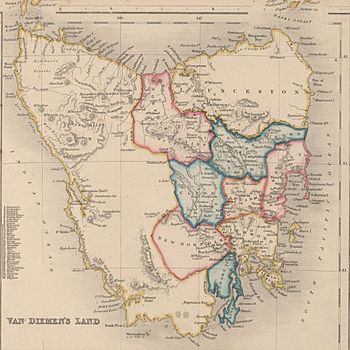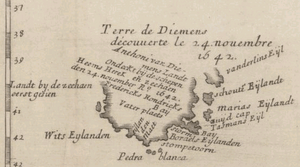Van Diemen's Land facts for kids

1852 map of Van Diemen's Land
|
|
| Geography | |
|---|---|
| Location | Southern Ocean |
| Coordinates | 42°00′S 147°00′E |
| Administration | |
|
United Kingdom (in 1855)
|
|
| Demographics | |
| Population | 40,000 |

Van Diemen's Land was the original name for Tasmania, an island that is now a state of Australia. Europeans used this name before they knew it was an island.
A Dutch explorer named Abel Tasman was the first European to map parts of Tasmania's coast in 1642. He named the land Anthoonij van Diemenslandt after Anthony van Diemen. Van Diemen was the Governor-General of the Dutch East Indies. He had sent Tasman on his journey to explore the southern lands.
In 1803, the British started a penal colony on the island. This meant they sent prisoners there. It was called Van Diemen's Land and was part of the British colony of New South Wales. In 1824, Van Diemen's Land became its own colony. George Arthur was its first Governor.
In 1856, Britain officially changed the name to Tasmania. People had been using this name for many years. The change happened because the citizens asked for it. That same year, the colony also gained the right to govern itself and set up its own parliament.
Contents
Life as a Penal Colony
From the 1830s until 1853, Van Diemen's Land was the main place in Australia where Britain sent prisoners. When Britain stopped sending prisoners to New South Wales, all convicts went to Van Diemen's Land. About 75,000 convicts were sent there. This was about 40% of all convicts sent to Australia.
Male convicts often worked as servants or farm workers for free settlers. They also worked in groups on public projects. The most difficult convicts were sent to a prison on the Tasman Peninsula called Port Arthur. Convicts who committed more crimes were also sent there.
Female convicts worked as servants in homes or were sent to a "female factory." These were like workhouse prisons for women. There were five female factories in Van Diemen's Land.
Many convicts who had finished their time or behaved well were given a "ticket-of-leave." This allowed them to leave Van Diemen's Land. A lot of them went to the new free colony of Victoria. However, free settlers in towns like Melbourne did not like the former convicts coming to their towns.
During the Australian gold rush, many settlers from Van Diemen's Land (called Vandemonians) went to the gold fields in Victoria. Places like Ballarat and Bendigo saw many of them. Britain stopped sending convicts to Tasmania in 1853.
Why the Name Changed
The name Van Diemen's Land was strongly linked to its past as a convict colony. Also, the name sounded a bit like the word "demon." Because of these reasons, the citizens asked for a name change. This request was approved in 1855, and the new name, Tasmania, became official on January 1, 1856. The island was named after explorer Abel Tasman. The last prison settlement in Tasmania, at Port Arthur, finally closed in 1877.
Van Diemen's Land in Popular Culture
Music Mentions
- The Australian folk song "The Wild Colonial Boy" mentions Van Diemen's Land.
- The band Flogging Molly often mentions Van Diemen's Land in their songs, like "Every Dog Has Its Day."
- Several Irish folk songs, such as "The Black Velvet Band" and "Back Home in Derry," talk about Van Diemen's Land.
- "Van Diemen's Land," also known as "The Gallant Poachers," is a traditional English and Scottish folk song.
- Steeleye Span sings a version of this traditional English folk song on their album They Called Her Babylon.
- "Van Diemen's Land" is the second song on U2's album Rattle and Hum. The Edge wrote and sang the words. The song remembers a Fenian poet named John Boyle O'Reilly, who was sent to Australia for his poetry.
- The chorus of the English folk song "Maggie May" says, "They've sent you to Van Diemen's cruel shore."
- The Irish song "Back Home in Derry" mentions Van Diemen's Land. Canadian songwriter Gordon Lightfoot wrote the music, and Irish Republican Bobby Sands wrote the words. Christy Moore sang it.
- Shirley Collins and the Albion Country Band recorded "Van Diemen's Land" on their album No Roses (1971).
- Carla Bruni sings the poem 'If You Were Coming In The Fall' by Emily Dickinson on her album No Promises. The song includes the line: "subtracting till my fingers dropped; into Van Diemen's Land."
Books Featuring Van Diemen's Land
- Gould's Book of Fish: A Novel in Twelve Fish by Richard Flanagan (2002) tells the story of a convict sent to Van Diemen's Land.
- In Cormac McCarthy's book Blood Meridian, a character called Bathcat, a "Vandiemenlander," appears in 1850s Mexico.
- In Edgar Allan Poe's Narrative of A. Gordon Pym, the main character stops at Van Diemen's Land on his way to the South Pole.
- Umberto Eco's book "The Island of the Day Before" (1994) mentions Van Diemen's Land. It's about a 17th-century Italian trapped on an island near the International Date Line.
- Emily Dickinson's poem "If You Were Coming in the Fall" mentions Van Diemen's Land.
- The Potato Factory by Bryce Courtenay (1995) uses a quote from Emily Dickinson's poem.
- In Gulliver's Travels by Jonathan Swift (1726), the country of Lilliput is said to be “to the north-west of Van Dieman's Land.”
- In The Convicts by Iain Lawrence, young Tom Tin is sent to Van Diemen's Land after being accused of murder.
- In James De Mille's A Strange Manuscript Found in a Copper Cylinder, a letter is found written by a British sailor who got lost after taking convicts to Van Dieman's Land.
- The Terror by Dan Simmons (2007) mentions Van Diemen's Land in chapters about Francis Crozier. This book is about the ships HMS Erebus and HMS Terror looking for the Northwest Passage.
- In Peter Carey's book, True History of the Kelly Gang, Van Diemen's Land is where Ned Kelly's parents faced hardships before moving to Victoria.
- English Passengers by Matthew Kneale (2000) tells the story of three English men who sail to Van Diemen's Land in 1857, searching for the Garden of Eden.
- Christopher Koch's novel "Out of Ireland" describes what it was like to be a convict in Van Diemen's Land.
- Wild Orchards by Isabel Dick (1955) tells the story of a young Englishwoman who marries a man from Van Diemen’s Land. It covers their struggles to build a home and touches on the treatment of the aboriginal people and the difficulties from the island being a penal colony.
Related Pages
See also
 In Spanish: Tierra de Van Diemen para niños
In Spanish: Tierra de Van Diemen para niños

